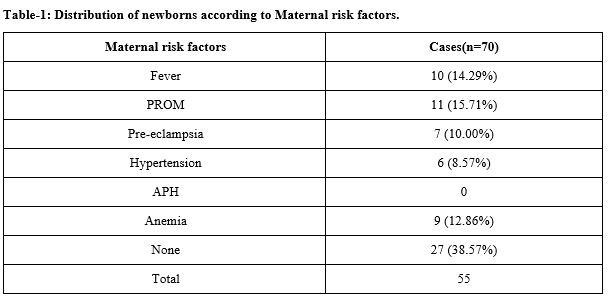Study of serum vitamin d levels and its association with neonatal sepsis among newborns
Abstract
Introduction: Vitamin D plays an important role in immune function. It plays an important role in the neonatal period in fetal skeletal growth, prevention of rickets, neonatal sepsis, respiratory tract infections, cardiovascular diseases, diabetes, and other endocrine disorders. It has been found that newborns' low level of cholecalciferol is closely related to neonatal sepsis.
Aims and Objectives: To determine the neonatal plasma cholecalciferol levels and severity of vitamin D deficiency in neonatal sepsis.
Material and Methods: This was a prospective, observational study conducted at Neonatal Care Intensive Unit of R. D. Gardi Medical College, Ujjain. The cases included all babies >34 weeks of gestational age having postnatal age of 0-28 days with clinical signs and laboratory findings of neonatal sepsis. Statistical analysis was performed using STATA 10.0.
Results: Total 70 newborns with sepsis were included in the study among which n=47 (67%) had deficient (less than 20ng/ml), n=16 (22.86%) had insufficient (between 20-30ng/ml) and n=7 (10.00%) of newborns had sufficient levels of cholecalciferol (more than 30ng/ml). The mean cholecalciferol levels among term were 18.53ng/ml (±4.8) and in preterm is 15.7ng/ml (±2.6) and this finding was statistically significant (p=0.04). The mean cholecalciferol in newborns with culture-positive sepsis was 14.8ng/ml (±6.04) and in culture-negative sepsis was 16.4ng/ml (±5.2) and this finding was statistically significant (p=0.02).
Conclusions: More than 65% of newborns were deficient in 25-OH cholecalciferol and the mean 25-OH cholecalciferol levels were lower in preterm than in term newborns and lower in newborns with culture-positive sepsis than in newborns with culture-negative sepsis.
Downloads
References
McGrath J, Saari K, Hakko H, Jokelainen J, Jones P, Järvelin MR, et al. Vitamin D supplementation during the first year of life and risk of schizophrenia: a Finnish birth cohort study. Schizophrenia Res. 2004;67(2-3):237-245.
Nagpal S, Na S, Rathnachalam R. Noncalcemic actions of vitamin D receptor ligands. Endocrine Rev. 2005;26(5):662-687.
Judd S, Tangpricha V. Vitamin D deficiency and risk for cardiovascular disease. Circulation. 2008;117(4):503.
Chhabra GS, Sodhi MK, Sharma, M. Clinical, hematopathological, and bacteriological profiles in neonatal septicemia and meningitis. Perinatol. 2016;17:54-61.
Prosser DE, Jones G. Enzymes involved in the activation and inactivation of vitamin D. Trends Biochem Sci. 2004;29(12):664-673.
Holick MF, Binkley NC, Bischoff-Ferrari HA, Gordon CM, Hanley DA, Heaney RP, et al. Evaluation, treatment, and prevention of vitamin D deficiency: an Endocrine Society clinical practice guideline. J Clin Endocrinol Metabol. 2011;96(7):1911-1930.
Kovacs CS. Vitamin D in pregnancy and lactation: maternal, fetal, and neonatal outcomes from human and animal studies. Am J Clin Nutri. 2008;88(2):520S-528S.
Polinski C. The value of the white blood cell count and differential in the prediction of neonatal sepsis. Neonatal network: NN. 1996;15(7):13-23.
Misra RN, Jadhav SV, Ghosh P, Gandham N, Angadi K, Vyawahare C. Role of sepsis screen in the diagnosis of neonatal sepsis. Med J Dr. DY Patil University. 2013;6(3):254.
Uriu-Adams JY, Obican SG, Keen CL. Vitamin D and maternal and child health: overview and implications for dietary requirements. Birth Defects Res C Embryo Today. 2013; 99(1):24-44.
Edwards MS BC. Sepsis in the newborn: In: Gershon AA, Hotez PJ, Katz SL, editors. Krugman’s Infectious Diseases of Children. 11th ed: Mosby; Philadelphia, PA, USA: 2004 pp 545-561.
Ballard JL, Khoury JC, Wedig KL, Wang L, Eilers-Walsman BL, Lipp R. New Ballard Score, expanded to include extremely premature infants. J Pediatr. 1991;119(3):417-423.
Cetinkaya M, Cekmez F, Buyukkale G, Erener-Ercan T, Demir FE, Tunc T, Aydın FN, Aydemir G. Lower vitamin D levels are associated with increased risk of early-onset neonatal sepsis in term infants. J Perinatol. 2015;35(1):39-45.

Copyright (c) 2020 Author (s). Published by Siddharth Health Research and Social Welfare Society

This work is licensed under a Creative Commons Attribution 4.0 International License.


 OAI - Open Archives Initiative
OAI - Open Archives Initiative


